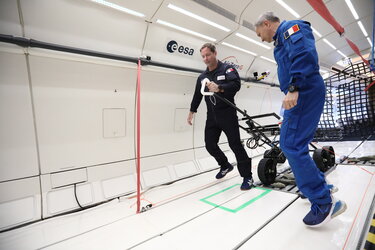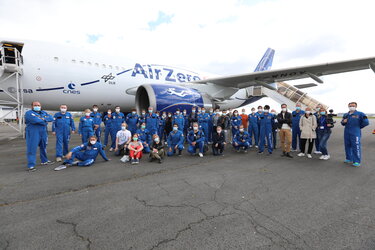Accept all cookies Accept only essential cookies See our Cookie Notice

About ESA
The European Space Agency (ESA) is Europe’s gateway to space. Its mission is to shape the development of Europe’s space capability and ensure that investment in space continues to deliver benefits to the citizens of Europe and the world.
Highlights
ESA - United space in Europe
This is ESA ESA facts Member States & Cooperating States Funding Director General Top management For Member State Delegations European vision European Space Policy ESA & EU Space Councils Responsibility & Sustainability Annual Report Calendar of meetings Corporate newsEstablishments & sites
ESA Headquarters ESA ESTEC ESA ESOC ESA ESRIN ESA EAC ESA ESAC Europe's Spaceport ESA ESEC ESA ECSAT Brussels Office Washington OfficeWorking with ESA
Business with ESA ESA Commercialisation Gateway Law at ESA Careers Cyber resilience at ESA IT at ESA Newsroom Partnerships Merchandising Licence Education Open Space Innovation Platform Integrity and Reporting Administrative Tribunal Health and SafetyMore about ESA
History ESA Historical Archives Exhibitions Publications Art & Culture ESA Merchandise Kids Diversity ESA Brand Centre ESA ChampionsLatest
Space in Member States
Find out more about space activities in our 23 Member States, and understand how ESA works together with their national agencies, institutions and organisations.
Science & Exploration
Exploring our Solar System and unlocking the secrets of the Universe
Go to topicAstronauts
Missions
Juice Euclid Webb Solar Orbiter BepiColombo Gaia ExoMars Cheops Exoplanet missions More missionsActivities
International Space Station Orion service module Gateway Concordia Caves & Pangaea BenefitsLatest
Space Safety
Protecting life and infrastructure on Earth and in orbit
Go to topicAsteroids
Asteroids and Planetary Defence Asteroid danger explained Flyeye telescope: asteroid detection Hera mission: asteroid deflection Near-Earth Object Coordination CentreSpace junk
About space debris Space debris by the numbers Space Environment Report In space refuelling, refurbishing and removingSafety from space
Clean Space ecodesign Zero Debris Technologies Space for Earth Supporting Sustainable DevelopmentLatest
Applications
Using space to benefit citizens and meet future challenges on Earth
Go to topicObserving the Earth
Observing the Earth Future EO Copernicus Meteorology Space for our climate Satellite missionsCommercialisation
ESA Commercialisation Gateway Open Space Innovation Platform Business Incubation ESA Space SolutionsLatest
Enabling & Support
Making space accessible and developing the technologies for the future
Go to topicBuilding missions
Space Engineering and Technology Test centre Laboratories Concurrent Design Facility Preparing for the future Shaping the Future Discovery and Preparation Advanced Concepts TeamSpace transportation
Space Transportation Ariane Vega Space Rider Future space transportation Boost! Europe's Spaceport Launches from Europe's Spaceport from 2012Latest

Gravity for the loss
Thank you for liking
You have already liked this page, you can only like it once!
Space agencies of Europe, assemble!
Last week, ESA, the German Aerospace Center (DLR) and French space agency CNES joined forces to run a special parabolic flight campaign entirely dedicated to life science experiments. Between 4 and 7 June, eight experiments were run in three different levels of partial gravity, another first for a parabolic flight campaign.
During our more common zero-gravity parabolic flights, research teams are subjected to 20-second bursts of weightlessness during which they run experiments ranging from life sciences, to technology demonstrations, to material physics. Results offer an indication of how various mechanisms work without gravity and are compared to results on the ground. But what happens at varying degrees of weightlessness?
To help fill in the graph, scientists were offered a unique opportunity to run experiments at one-quarter, one-half, and three-quarters gravity. The aim is to better understand biological dependence on gravity. Ultimately, if humans are to embark on long-term spaceflight and live on the Moon and Mars, we need to determine the levels of gravity in which humans can live and work.
One experiment investigated the effects of partial gravity on brain function. Previous studies have shown that short exposure to microgravity increased neurocognitive functions due to increased blood flow to the brain. However, longer-term spaceflight, in which increased blood flow to the brain is more permanent, showed negative effects on cognition. In this campaign, studying the phenomenon in partial gravity is helping scientists better understand where we draw the line for optimal performance.
Another team subjected baby plant roots to doses of partial gravity and monitored root growth using lasers to investigate how the roots manage to stay “grounded” in the absence of gravity. We know plants adapt to weightlessness rather quickly, but researchers still need a clearer picture of what’s happening on a cellular level. Extra-terrestrial farming is vital to human survival off-planet, and adapting agriculture to altered gravity is an important step to making this possible. For a full list of experiments, see here.
Parabolic flights are one of a few ways to recreate microgravity conditions on Earth, but how is this achieved? The A310 Zero-G aircraft, operated by Novespace in Bordeaux, France, repeatedly performs a special manoeuvre. After pulling up sharply to 50 degrees, the pilots reduce the thrust and pitch of the airplane to cancel air-drag and lift. This places the plane on a parabolic flight path, exactly as if it has been thrown upwards and released. It then essentially falls over the top of the parabola, creating 20 seconds of 0g. When it reaches 50 degrees nose-down, the plane then pulls out of the descent to normal flight.
To achieve partial gravity, the angle at which the plane pulls up and pulls out is shallower, and the pilots carefully cancel out only part of the lift. This creates about 25 seconds of one-quarter gravity, or 35 seconds of half-gravity, or 50 seconds of three-quarters gravity. The manoeuvre is performed every three minutes for a total of 31 times per flight. Watch a tour of the Zero-G aircraft here.
In addition to this unique collaboration between ESA, DLR, and CNES, the partial gravity parabolic flight campaign also featured a special guest experiment by NASA and pilot-turned-ESA-astronaut Thomas Pesquet.
"It was a real privilege to work on this unique campaign, not only because of the constructive collaboration with my colleagues from DLR and CNES, but also to provide such an interesting suite of experiments with rare and much-needed data,” said Neil Melville, Coordinator of Parabolic flight and Drop Tower campaigns. He is pictured on the left, alongside Katrin Stang of DLR (middle) and Sébastien Rouquette of CNES (right).
“We are certainly looking forward to the results the science teams will publish once their analyses are completed, and hope to perform a similar campaign in the future."
ESA conducts 0g parabolic flight campaigns twice per year for microgravity research. Learn more here.
-
CREDIT
Novespace -
LICENCE
ESA Standard Licence

72nd ESA parabolic flight campaign

ESA’s 71st parabolic flight campaign experiments

Preparing 'flow boiling heat transfer at low gravity…

Gravity goes lunar: putting LESA to the test















 Germany
Germany
 Austria
Austria
 Belgium
Belgium
 Denmark
Denmark
 Spain
Spain
 Estonia
Estonia
 Finland
Finland
 France
France
 Greece
Greece
 Hungary
Hungary
 Ireland
Ireland
 Italy
Italy
 Luxembourg
Luxembourg
 Norway
Norway
 The Netherlands
The Netherlands
 Poland
Poland
 Portugal
Portugal
 Czechia
Czechia
 Romania
Romania
 United Kingdom
United Kingdom
 Slovenia
Slovenia
 Sweden
Sweden
 Switzerland
Switzerland

























